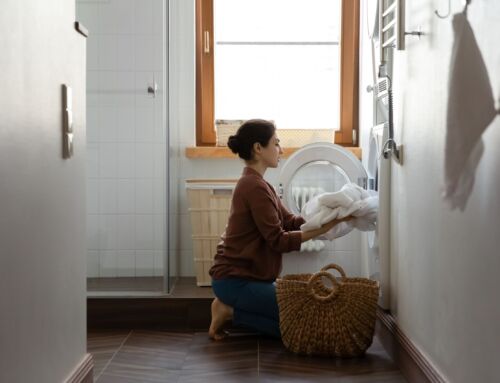Are you burdened by unsightly bath stains in your tub? How can you sit back and relax in your tub with a good book if your tub doesn’t look shiny and clean?
A dirty tub is a pain, and many of us neglect this step in our bathroom cleaning process. After all, doesn’t a tub clean itself when you’re bathing?
Not really.
We want to help you get your tub back in tip-top condition. Whether you have basic grime from day-to-day, stubborn stains, or even minor stains from hair dye, we’ve got you covered with a few bathroom cleaning and stain removal tips and tricks.
Keep reading to learn all about removing stains from your bathtub.
Clean The Tub
The first step in removing (and preventing) stains is giving your tub the deep clean it needs.
You should clean your tub every time you clean your bathroom, preferably weekly. This will make sure there’s never too much of a mess and there isn’t enough time for stains to set in.
You can use your normal bathroom cleaners and wipe down the tub, making sure not to neglect the faucet and the drain. You could also make DIY cleaners (like many of the cleaners that we’ll be using later in this article) or vinegar for a more gentle clean.
Determine the Type of Tub
There are a few different kinds of tubs and each one will handle different levels of cleaners and abrasiveness.
Make sure that you know what you’re working with before you get started so you can avoid any unnecessary damage to your tub. Scratches and cracks are more difficult and expensive to handle than stains.
Porcelain Tubs
Porcelain tubs are uncommon in newer homes but were popular in homes built in the early to mid-1900s.
These tubs are sturdy, so they have a high tolerance for harsh or abrasive cleansers. That said, you don’t always need to use them.
Anything from mild cleansers like vinegar or dish soap to abrasive cleaning pads and chemicals works for porcelain tubs.
Acrylic Tubs
Acrylic tubs are the most common tubs in modern homes. Tubs that look and feel like plastic are all acrylic.
These tubs aren’t great for the use of harsh chemicals. They can discolor and crack easily, meaning that your stain can lead to another stain (that’s harder to remove) or expensive damage.
Gentle soaps, non-abrasive sponges, and eraser pads are great for acrylic tubs. You don’t want to use scrubbing brushes or anything with a sandpaper texture.
Enamel Tubs
Enamel tubs are less common than acrylic tubs. You can determine if you have an enamel tub by using a magnet. If it sticks, you have enamel.
Enamel tubs shouldn’t come in contact with abrasive chemicals unless it’s necessary. This means that you should avoid bleach and vinegar for anything beyond a quick rinse.
Instead of using the suggestions mentioned later in this article, use powdered cleaners for stubborn stains. Make a paste from the cleaner and a small amount of water, let it sit, and use a soft sponge to remove it.
Determine the Type of Stain
Different stains are going to have different requirements. Almost all stains can be removed, but you need to know what you’re dealing with to remove them efficiently.
Remember your type of tub before you get started and make adjustments based on its ability to handle chemicals and abrasion.
Mild Stains
Mild stains are easy. Just because something doesn’t come off with your regular cleaning doesn’t mean that it isn’t removable with a bit of elbow grease. Milder stains are often soap scum or scuffs.
Mix a half-and-half mixture of white vinegar and water and put it in a spray bottle. Spray it onto the stains and let it sit for fifteen to twenty minutes.
Use a soft brush to scrub at the stain after the fifteen minutes, but don’t remove the mixture. It should turn into a bubbling paste.
Wait fifteen more minutes and wipe the paste away. Rinse, and your stain should be gone.
Difficult Stains
Maybe your stains are more difficult. If they’re not rust or mineral stains (coming up next), you’ll need to work harder.
Before moving to heavy chemicals, mix a one to three mixture of hydrogen peroxide and baking soda. This should make a thick paste. Apply the paste to the stain and leave for up to an hour. The tougher the stain, the longer you should leave it. Wipe the mixture away and rinse and the stain should be gone, though you may need to repeat the process.
If you have something harder to remove, like hair dye, you may need to resort to bleach. Rinse well before bleaching. Try the other mixture first, but if it doesn’t work, add one part bleach to one part water. Apply the mixture to the stain and leave for about ten minutes.
Wipe it away and the stain should be reduced or gone entirely. If it’s still there, repeat the next day.
Rust Stains
Rust stains look scary, but they aren’t hard to remove.
Mix borax with enough lemon juice to make a thick paste. You won’t need much of either product, so start with only a sprinkle of borax. Apply the paste and let it sit for no more than thirty minutes, and wipe away with a soft sponge or rag.
When you rinse, the rust stains should be gone.
Mineral Stains
Mineral stains, or hard water stains, are pesky.
Soak a paper towel or rag in white vinegar and lay it over the stain. After an hour or two (depending on the intensity of the stain) remove the towel and sprinkle the area with baking powder. Spray on your water and vinegar mixture that you made for mild stains and scrub it until paste forms.
Leave the paste for five to ten minutes and rinse.
Bath Stains Are a Pain
Are you tired of looking at your bath stains? Try one of the methods above to get rid of them for good. Make sure to start a regular cleaning regime in your bathroom to prevent future staining.
If you want help with your cleaning routine, we’ve got you covered. Contact us to get a professional cleaning service for your home. We can take care of the deep clean that your bathroom needs.









